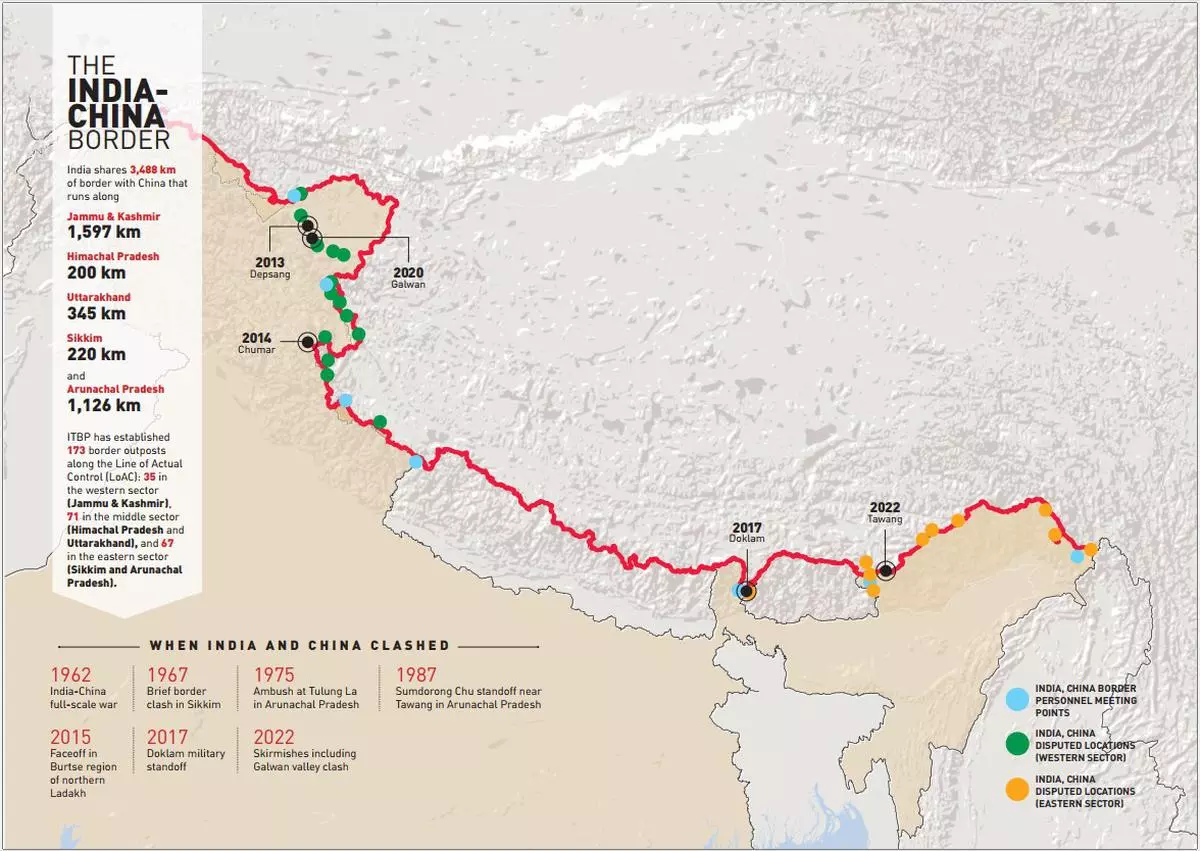International Relations
Dealing with the China
- 19 Apr 2023
- 7 min read
This editorial is based on “A message for the planners in dealing with the Dragon” which was published in The Hindu on 19/04/2023. It talks about China's geopolitical ambitions that have implications for India, and India needs to be prepared for any dynamic activity at its border.
For Prelims: Galwan Valley,Tawang sector, Line of Actual Control (LAC)
For Mains: India China Border dispute
The recent developments in India-China relations have raised concerns about the possibility of a future conflict between the two nations. The use of Sun Tzu's philosophy of winning without fighting has also been questioned, with others arguing that China is preparing for war.
India and China's strained relationship has been fueled by recent Chinese provocations, including the allocation of names to places in Arunachal Pradesh, denial of visas to Indian media personnel, and President's statements on preparing for war. These events have led to concerns about China's intentions and the need for India to be prepared for any eventualities.
In this context, India's defence preparedness has come under scrutiny, with the Parliamentary Standing Committee on Defence highlighting the need for urgent modernisation of the armed forces.
What are the Causes of the India-China Conflict?
- The Dispute: India-China relations have gone through cycles of conflict and cooperation over nearly 75 years.
- The most serious recent episodes of conflict were in Galwan Valley in Ladakh in 2020 and in Tawang in Arunachal Pradesh in 2022.
- Observers on both sides of the border—the Line of Actual Control (LAC)—agree that the number of serious military confrontations has increased since 2013.
- No Clear Demarcation: The border between India and China is not clearly demarcated throughout and there is no mutually agreed Line of Actual Control (LAC) along certain stretches.
- LAC came into existence after the 1962 Indo China war.
- India-China border is divided into three sectors.
- Western Sector : Ladakh
- Middle Sector : Himachal Pradesh and Uttarakhand
- Eastern Sector: Arunachal Pradesh and Sikkim
- Partnerships with each other's main enemies, including the Soviet Union/Russia and the United States, have prevented them from becoming strategic partners and cooperating on strategic matters.
- The growing power gap between China and India, with China's GDP being five times that of India's, has made it difficult for India to be accommodative without appearing to surrender.
- Infrastructure build-up, particularly in Tibet, has led to a security dilemma in which military relations go into a spiral that could tempt one side or both to go to war.
What have been the Border Dispute Settlement Mechanisms?
- The Agreement on the Maintenance of Peace and Tranquility:
- It was signed in 1993, which called for a renunciation of the use of force, recognition of the LAC, and the resolution of the border issue through negotiations.
- The Agreement on Confidence Building Measures in the Military Field along the LAC:
- It was signed in 1996, which laid down pledges on non-aggression, prior notification of large troop movements, and exchange of maps to resolve disagreements over the LAC.
- The Border Defence Co-operation Agreement:
- It was signed in 2013 following the Depsang Valley incident.
What the Parliamentary Standing Committee on Defence's Report Says?
- The Indian Air Force's deterrent and striking power would be vital in any India-China conflict.
- The government should consider buying state-of-the-art fifth-generation fighter aircraft without losing time to keep the force in a comfortable position.
- Slow production rate of the Tejas fighter by Hindustan Aeronautics Limited is adversely affecting the IAF.
- The supply of 40 LCA Tejas jets from Hindustan Aeronautics Limited (HAL) has been considerably delayed and needs attention.
- Urgent need to make up the dwindling squadron numbers through the 114 Multi Role Fighter Aircraft project.
- Similar observations were made for hardware procurement for the Indian Army and Indian Navy.
- The Ministry of Defence should make a final decision on having a third aircraft carrier, which would enhance India's maritime capabilities.
- Committee recommends allocation for defense should be 3% of GDP to maintain India's deterrent posture.
What Should be the Way Forward?
- Diplomatic Engagement:
- It is crucial to maintain open channels of communication to avoid any misunderstandings or escalation of tensions.
- Reassess Defence Acquisition Plans:
- India needs to re-evaluate its defence acquisition plans to ensure that they are geared towards long-term sustainability, rather than just possessing capability.
- Prepare for Potential Conflict:
- India needs to prepare for the possibility of conflict with China, particularly given the Chinese President's recent articulations at the National People's Congress.
- This preparation should involve bolstering India's military capabilities, particularly in the Indian Air Force, Indian Army, and Indian Navy.
- Allocate Adequate Funds for Defence:
- The Parliamentary Standing Committee on Defence has recommended that allocation for defence should be 3% of GDP to maintain India's deterrent posture.
- The Indian government should seriously consider this recommendation and allocate sufficient funds for defence, rather than relying on emergency armament purchases from abroad.
- Emphasize Negotiations from a Position of Strength:
- India should adopt a negotiating strategy that emphasizes its strength and power, rather than capitulation.
- This would involve casting a shadow of power across the bargaining table and making it clear that India is prepared to defend its interests.
- Border Infrastructure Development:
- Development of infrastructure along the border, such as roads and bridges, can help both countries access remote areas and reduce the possibility of any misunderstandings or conflicts.
|
Drishti Mains Question In the light of the recent remarks of the Parliamentary Standing Committee on Defence, critically evaluate India's preparedness to counter China's growing military ambitions. (150 words) |







